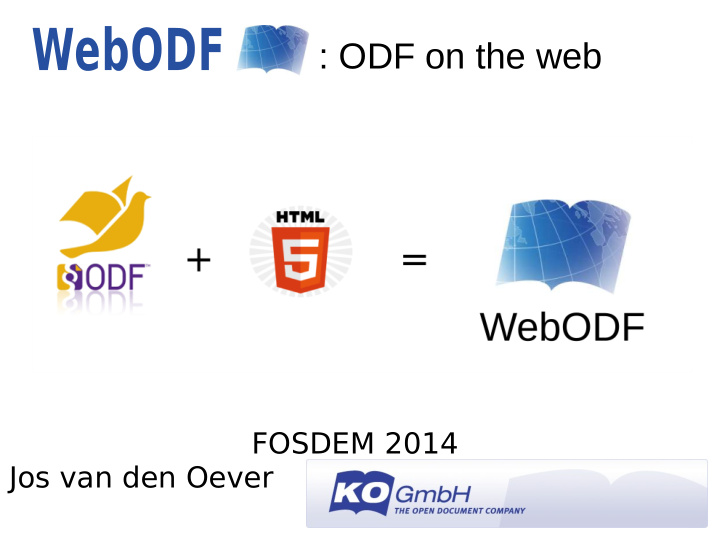



: ODF on the web FOSDEM 2014 Jos van den Oever
Overview ● What is it? ● Demo – Viewer.js – ODF editor – Collaborative ODF editor ● How does it work? – ODF in the browser – Collaborative editing ● How to use it? : ODF on the web
WebODF ● Since 2010 ● Initial work sponsored by NLNet ● Since then: improved by investments from customers and contributions by commercial users ● Written in JavaScript with HTML ● Smaller than the average document (85kb, 40k loc) ● http://webodf.org/ and on GitHub
Viewer.js ● Combinatie van PDF viewer en ODF viewer ● Eenvoudig te gebruiken in webpagina's ● Ook gesponsord door NLNet ● http://viewerjs.org = + WebODF <demo url=”http://viewerjs.org”/>
WebODF in NVivo ● NVivo: desktop application by QSR International ● Application to manage research materials ● Works on Mac en Windows ● WebODF used as 'invisible' component for text editing ● QSR contributes many features : ODF on the web
WebODF for text editing ● WebODF combined with a graphical interface (Dojo) ● Works completely in the browser ● No conversion to HTML ● Document structure unaltered <demo url=”http://webodf.org/demo”/>
Documents ● ownCloud: software for a cloud under your control ● Share en synchronize files, music, images, calendar, todos ● Community and enterprise versions ● Version 6: collaborative editing of text documents
Documents ● First idea: FOSDEM 2013 ● Group of people can edit a document at the same time ● Complete edit history is available ● Each user has a distinct color and cursor <demo url=”http://demo.viewerjs.org:23456/programs/editor/”/>
Where (else) can WebODF be used? ● Publication of ODF documents ● Work flow with display, annotation or editing of text documents ● Component in CMS, DMS, document generation ● Custom programming with JavaScript ● Collaborative editing of text documents WebODF
How does it work? ODF in the browser The ZIP contains: content.xml, styles.xml, settings.xml, meta.xml : ODF on the web
How does it work? Collaborative editing General implementation • Each edit action is an operation • Operations are sent to the central node • Central node can be a server or participant • Web Socket, GET/PUT, minimal server logic ⤢ ⤡ ⇄ : ODF on the web
How does it work? Collaborative editing ownCloud implementation • Requirements: run on any XAMP stack • Numbered operations are added to database table • Clients resolve conflicts themselves • Server has complete edit history ⤢ ⤡ ⇄ : ODF on the web
What else is in the box? ● Mandatory JSLint checks ● Closure compiler for minification and type checking ● >500 unit tests runnable in Node.js and target browsers ● Detailed reporting of code coverage ● Continuous integration server ● Mandatory code reviews ● XML Schema validation (ongoing) ● Relax NG validation (element level) Object Oriented code base: C++ coders will feel at home : ODF on the web
What do you need? ● A web browser ● Text editor (optional, see above) ● No fear of JavaScript ● IRC client (#webodf on freenode) ● Recent example project: Sodfa, offline editing with server sync – https://github.com/iivvoo/sodfa : ODF on the web
Ideas for the roadmap ● General XML editor ● Floating UI elements, pluggable editing components ● Mobile international keyboard interaction (done by QSR) ● Presentation and spreadsheet editor ● Collaborate live with desktop software (e.g. LibreOffice, OpenOffice) ● Spelling and grammar check ● Lock parts of the document ● Images, table, header/footer editor ● Server-side library ● Import OOXML : ODF on the web
Recommend
More recommend